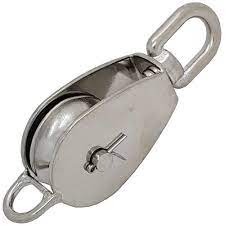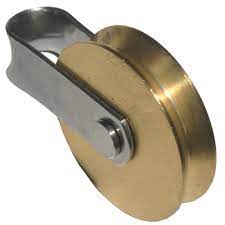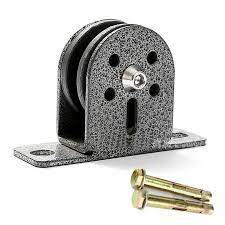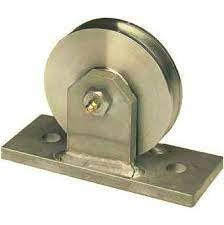Product Description

What safety considerations should be kept in mind when using rope pulleys?
When using rope pulleys, several safety considerations should be kept in mind to ensure the well-being of individuals and the proper functioning of the pulley system. Here's a detailed explanation of the safety considerations:
1. Equipment Inspection:
Before using rope pulleys, it is essential to inspect them thoroughly for any signs of damage, wear, or malfunction. Check for cracks, deformation, sharp edges, or corrosion that could compromise the pulley's structural integrity. Inspect the attachment points, bearings, and axles to ensure they are secure and functioning properly. If any issues are detected, the pulley should be taken out of service and replaced or repaired as necessary.
2. Rope Compatibility:
Ensure that the rope used with the pulleys is compatible in terms of diameter, type, and strength. The rope should fit properly within the pulley's groove, without excessive slack or binding. Using an incompatible rope can lead to performance issues, increased wear, or even catastrophic failure. Refer to the manufacturer's recommendations for the appropriate rope specifications for the specific pulley.
3. Weight and Load Limits:
Respect the weight and load limits specified by the manufacturer for the pulley. Overloading a pulley can lead to excessive wear, deformation, or failure. Consider the combined weight of the load, the forces exerted during movement or lifting, and any potential dynamic loads. Ensure that the pulley and its associated components, such as anchor points and ropes, are rated to handle the expected loads safely.
4. Proper Installation:
Ensure that the pulleys are properly installed and securely attached to the anchor points or mounting systems. Follow the manufacturer's instructions for correct installation techniques, such as using appropriate connectors, carabiners, or knots. Improper installation can lead to pulley slippage, unexpected movement, or detachment, compromising the safety and functionality of the system.
5. Redundancy and Backup Systems:
In critical applications or high-risk scenarios, consider incorporating redundancy and backup systems. This might include using multiple pulleys in parallel or establishing secondary anchor points. Redundancy helps mitigate the risk of a single point of failure and enhances the overall safety and reliability of the pulley system.
6. Proper Use of Personal Protective Equipment (PPE):
When using rope pulleys, ensure that the appropriate Personal Protective Equipment (PPE) is worn. This may include helmets, harnesses, gloves, and eye protection, depending on the specific activity and the associated hazards. PPE helps protect against potential falling objects, impacts, abrasions, or other risks associated with the use of pulleys.
7. Training and Competency:
Ensure that individuals operating the pulley system have received adequate training and possess the necessary competency for the specific activities. Proper training should cover topics such as pulley operation, rope handling techniques, safety procedures, and emergency response protocols. Competent individuals should be able to assess risks, make informed decisions, and respond effectively to any unforeseen circumstances that may arise during pulley operations.
8. Regular Maintenance and Inspection:
Implement a regular maintenance and inspection program for the pulley system. This includes periodic inspection of the pulleys, ropes, connectors, and anchor points. Lubrication of the pulley bearings, as recommended by the manufacturer, can help maintain their smooth operation. Regular maintenance helps identify and address any potential issues or wear before they compromise the safety and performance of the pulley system.
9. Environmental Considerations:
Take into account the environmental conditions in which the pulley system will be used. Factors such as temperature, humidity, exposure to moisture, or corrosive substances can affect the performance and lifespan of the pulleys and associated components. Consider using pulleys with appropriate corrosion resistance or protective coatings when operating in harsh environments.
10. Emergency Preparedness:
Have an emergency response plan in place and ensure that all individuals involved in the pulley operation are familiar with it. The plan should include procedures for rescuing individuals, addressing equipment failures, and handling unforeseen emergencies. Regular drills and practice sessions can help reinforce emergency preparedness and enhance the ability to respond effectively in critical situations.
In conclusion, keeping these safety considerations in mind when using rope pulleys is crucial for ensuring the well-being of individuals and the proper functioning of the pulley system. Proper equipment inspection, rope compatibility, adherence to weight and load limits, correct installation, redundancy, PPE usage, training, regular maintenance, environmental considerations, and emergency preparedness all contribute to a safe and reliable pulley operation.
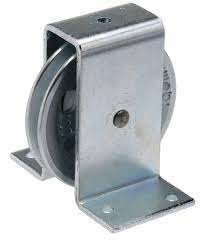
Are there different types of rope pulleys, and how do they differ in applications?
Yes, there are different types of rope pulleys designed for various applications. Each type of pulley offers specific features and advantages that make them suitable for different uses. Here's a detailed explanation of some common types of rope pulleys and how they differ in applications:
1. Fixed Pulleys:
Fixed pulleys are the simplest type of pulleys and have a stationary axle. They change the direction of the force applied to the rope but do not provide any mechanical advantage. Fixed pulleys are commonly used in applications where the purpose is to redirect the force or change the direction of the rope, such as flagpoles, clotheslines, or simple lifting systems. They do not reduce the effort required to lift the load.
2. Movable Pulleys:
Movable pulleys have an axle that can move along with the load. They provide a mechanical advantage by reducing the amount of force required to lift a load. The rope is threaded through the pulley, and one end is attached to a fixed point while the other end is used to apply force. Movable pulleys are commonly used in systems like block and tackle setups, where multiple pulleys are used in conjunction to distribute the load and provide a mechanical advantage. This type of pulley is often used in lifting heavy objects or in applications where a user wants to reduce the effort needed to move a load.
3. Compound Pulleys:
Compound pulleys, also known as combination pulleys, are a combination of fixed and movable pulleys. They provide an increased mechanical advantage compared to a single movable pulley. Compound pulleys consist of multiple pulleys, with some being fixed and others being movable. By combining fixed and movable pulleys, compound pulleys offer an even greater reduction in the force required to lift a load. They are commonly used in applications where heavy loads need to be lifted with minimal effort, such as in construction, rigging, or industrial settings.
4. Snatch Blocks:
Snatch blocks are a specialized type of pulley that is designed with a hinged side plate or a removable sheave. This feature allows the rope to be inserted into the pulley without threading it through one end. Snatch blocks are commonly used in applications where the rope cannot be easily threaded through the pulley due to its length or the presence of knots or attachments. They are frequently used in rigging, towing, or recovery operations.
5. Self-Locking Pulleys:
Self-locking pulleys, also known as progress capture pulleys, have a mechanism that automatically locks the pulley in place when a load is applied. This feature prevents the rope from slipping backward, providing additional safety and security. Self-locking pulleys are commonly used in applications where the load needs to be held securely in position, such as in rock climbing, rescue operations, or hauling heavy objects vertically.
6. Rescue Pulleys:
Rescue pulleys are specifically designed for use in emergency and rescue scenarios. They are typically lightweight, compact, and have additional features like side plates that open to allow the rope to be easily inserted or removed without detaching the pulley from the anchor. Rescue pulleys are commonly used in situations like mountaineering, caving, or search and rescue operations.
In summary, there are different types of rope pulleys, including fixed pulleys, movable pulleys, compound pulleys, snatch blocks, self-locking pulleys, and rescue pulleys. Each type of pulley offers unique features and advantages that make them suitable for specific applications. Understanding the different types of pulleys and their characteristics helps in selecting the appropriate pulley for a particular task or use case.

What types of ropes or cables are typically used with rope pulleys?
Rope pulleys can accommodate various types of ropes or cables depending on the specific requirements of the application. Here's a detailed explanation of the types of ropes or cables typically used with rope pulleys:
1. Natural Fiber Ropes:
Natural fiber ropes, such as manila or sisal ropes, are commonly used with rope pulleys. These ropes are made from natural materials, offering good grip and flexibility. They are suitable for applications where the load is not excessively heavy and where some stretching or elongation is acceptable. Natural fiber ropes are often used in recreational activities, gardening, and general-purpose lifting tasks.
2. Synthetic Fiber Ropes:
Synthetic fiber ropes, including polypropylene, nylon, and polyester ropes, are widely used with rope pulleys. These ropes offer excellent strength, durability, and resistance to abrasion and weather conditions. Synthetic fiber ropes are available in different grades and constructions, allowing users to select the appropriate rope based on the load capacity and specific environment. They are commonly used in industries such as construction, shipping, and recreation.
3. Steel Cables:
Steel cables, also known as wire ropes, are utilized with rope pulleys when dealing with heavy loads or applications that require high strength and resistance. Steel cables consist of multiple strands of steel wire twisted together, providing exceptional tensile strength and durability. They are often used in construction, mining, rigging, and industrial lifting operations. Steel cables offer superior resistance to corrosion and can withstand heavy loads and harsh environments.
4. Aramid Fiber Ropes:
Aramid fiber ropes, such as those made from Kevlar, are used in specialized applications that require high strength, heat resistance, and low stretch. Aramid fiber ropes are lightweight yet extremely strong, making them suitable for tasks such as industrial lifting, aerospace, and military operations. These ropes offer excellent resistance to chemical degradation and are often preferred in environments where other materials may not perform optimally.
5. Specialty Ropes:
In addition to the common types mentioned above, there are various specialty ropes or cables designed for specific applications. For example, static ropes or static kernmantle ropes are used in rope access, rock climbing, and rescue operations where low stretch and high strength are crucial. Dynamic ropes are specifically designed for applications that involve absorbing energy, such as climbing falls. Specialty ropes are often engineered with specific properties to meet the unique demands of their intended use.
It's important to note that the selection of the appropriate rope or cable for a rope pulley system depends on factors such as the load capacity, environmental conditions, desired stretch or elongation, and safety requirements. Users should consult the manufacturer's recommendations and consider the specific needs of their application to ensure the proper selection and use of ropes or cables with rope pulleys.


editor by CX
2024-04-29


